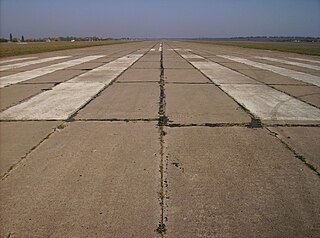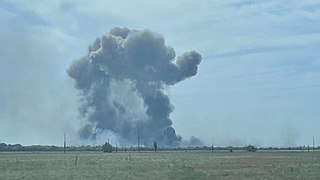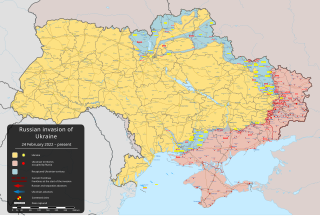
The M142 High Mobility Artillery Rocket System (HIMARS) is a light multiple rocket launcher developed in the late 1990s for the United States Army and mounted on a standard U.S. Army Family of Medium Tactical Vehicles (FMTV) M1140 truck frame.

The MGM-140 Army Tactical Missile System is a tactical ballistic missile designed and manufactured by the US defense company Ling-Temco-Vought (LTV), and later Lockheed Martin through acquisitions. It uses solid propellant, is 13 feet (4.0 m) high and 24 inches (610 mm) in diameter, and the longest range variants can fly up to 190 miles (300 km). The missiles can be fired from the tracked M270 Multiple Launch Rocket System (MLRS) and the wheeled M142 High Mobility Artillery Rocket System (HIMARS).

The Tupolev Tu-22M is a supersonic, variable-sweep wing, long-range strategic and maritime strike bomber developed by the Tupolev Design Bureau in the 1960s. The bomber was reported as being designated Tu-26 by Western intelligence at one time. During the Cold War, the Tu-22M was operated by the Soviet Air Forces (VVS) in a missile carrier strategic bombing role, and by the Soviet Naval Aviation in a long-range maritime anti-shipping role. As of 2021, there were 66 of the aircraft in service.

The Beriev A-50 is a Soviet-origin airborne early warning and control (AEW&C) aircraft that is based on the Ilyushin Il-76 transport plane. Developed to replace the Tupolev Tu-126 "Moss", the A-50 first flew in 1978. Its existence was revealed to the Western Bloc in 1978 by Adolf Tolkachev. It entered service in 1985, with about 40 produced by 1992.

The Black Sea Fleet is the fleet of the Russian Navy in the Black Sea, the Sea of Azov and the Mediterranean Sea. The Black Sea Fleet, along with other Russian ground and air forces on the Crimean Peninsula, are subordinate to the Southern Military District of the Russian Armed Forces. The fleet traces its history to its founding by Prince Potemkin on 13 May 1783 as part of the Imperial Russian Navy. The Russian SFSR inherited the fleet in 1918; with the founding of the Soviet Union in 1922, it became part of the Soviet Navy. Following the collapse of the Soviet Union in 1991, the Black Sea Fleet was partitioned between the Russian Federation and Ukraine in 1997, with Russia receiving title to 82% of the vessels.

The Russian Air Force is a branch of the Russian Aerospace Forces, the latter being formed on 1 August 2015 with the merging of the Russian Air Force and the Russian Aerospace Defence Forces. The modern VVS was originally established on 7 May 1992 following Boris Yeltsin's creation of the Ministry of Defence. However, the Russian Federation's air force can trace its lineage and traditions back to the Imperial Russian Air Service (1912–1917) and the Soviet Air Forces (1918–1991).

Kursk Vostochny Airport, also known as Khalino airbase, Kursk-Khalino, is an interceptor aircraft base in Kursk Oblast, Russia, with a single 2,500 m (8,200 ft) runway located 7 km east of Kursk. It has been used for many decades as a military airbase and has had periods of time in which it was also utilized as a commercial airport. It is located 4 miles northeast of Kursk and is considered a medium-sized base, with several alert pads. A civilian tarmac is located on the southern side of the airfield, which utilizes the common runway facilities.

Engels-2 is a strategic bomber military airbase in Russia located 14 kilometres (8.7 mi) east of Saratov. Engels is a major bomber operations base, and is Russia's sole operating location for the Tupolev Tu-160 strategic bomber. The base has a 3,500-metre (11,500 ft) runway and about 10 large revetments. It is named after the nearby city of Engels, which is named after the Communist philosopher, Friedrich Engels.

A military airfield in Belbek, a village near Sevastopol, Crimea, was also used for civil aviation, named Sevastopol International Airport Belbek, for six years from 2002 to 2007 under Ukrainian administration.

Novofedorivka is an urban-type settlement. It is located about 3 kilometres (1.9 mi) south of the regional centre of Saky, and about 70 kilometres (43 mi) north of Sevastopol.
Berdiansk Airport is an airport in Berdiansk, Ukraine. The airport is located 1.5 km (0.9 mi) north of the city.

Tiraspol Airport is an airport located in Tiraspol. It previously served as a military air base.

On 24 February 2022, the Chuhuiv Air Base in Chuhuiv, Kharkiv Oblast, Ukraine was the target of an air strike by Russian forces as part of the eastern Ukraine offensive during the 2022 Russian invasion of Ukraine.

There have been attacks in mainland Russia as a result of the Russian invasion of Ukraine, which began on 24 February 2022. The main targets have been the military, the arms industry and the oil industry. Many of the attacks have been drone strikes, firebombing, and rail sabotage. The Ukrainian intelligence services have acknowledged carrying out some of these attacks. Others have been carried out by anti-war activists in Russia. There has also been cross-border shelling, missile strikes and ground raids from Ukraine, mainly in the Belgorod, Kursk and Bryansk oblasts. Several times, Russian anti-Kremlin paramilitaries have launched incursions from Ukraine into Russia, captured border villages and battled the Russian military. While Ukraine has supported these ground incursions, it has denied direct involvement.

Saky is an air base adjacent to the settlement of Novofedorivka, Crimea. It was initially built by the Soviet Union in the 1930s, and has been operated under both Ukrainian and Russian sovereignty since 1992.

Several large explosions occurred at the Saky airbase in the town of Novofedorivka, Crimea, on 9 August 2022, during the Russian invasion of Ukraine. The military base was seized by Russian forces during the 2014 annexation of Crimea, part of the Russo-Ukrainian War. The explosions destroyed a number of Russian warplanes and caused substantial other damage. Ukrainian authorities tacitly took responsibility at first, until four weeks after the event, when Valerii Zaluzhnyi, Ukraine's military commander, explicitly said that it had been a Ukrainian missile strike.
This timeline of the Russian invasion of Ukraine covers the period from 24 February 2022, when Russia launched a military invasion of Ukraine, to 7 April 2022 when fighting focused away from the north and towards the south and east of Ukraine.

Beginning in July 2022, a series of explosions and fires occurred on the Russian-occupied Crimean Peninsula from where the Russian Army had launched its offensive on Southern Ukraine during the Russian invasion of Ukraine. Occupied since 2014, Crimea was a base for the subsequent Russian occupation of Kherson Oblast and Russian occupation of Zaporizhzhia Oblast. The Ukrainian government has not accepted responsibility for all of the attacks.

Aerial warfare in the Russian invasion of Ukraine began at dawn of 24 February 2022, with infantry divisions and armored and air support in Eastern Ukraine, and dozens of missile attacks across Ukraine. The first fighting took place in Luhansk Oblast near the village of Milove on the border with Russia at 3:40 am Kyiv time. The main infantry and tank attacks were launched in four spearhead incursions, creating a northern front launched towards Kyiv, a southern front originating in Crimea, a south-eastern front launched at the cities of Luhansk and Donbas, and an eastern front. Dozens of missile strikes across Ukraine also reached as far west as Lviv. Drones have also been a critical part of the invasion, particularly in regards to combined arms warfare. Drones have additionally been employed by Russia in striking Ukrainian critical infrastructure, and have been used by Ukraine to strike military infrastructure in Russian territory.



















